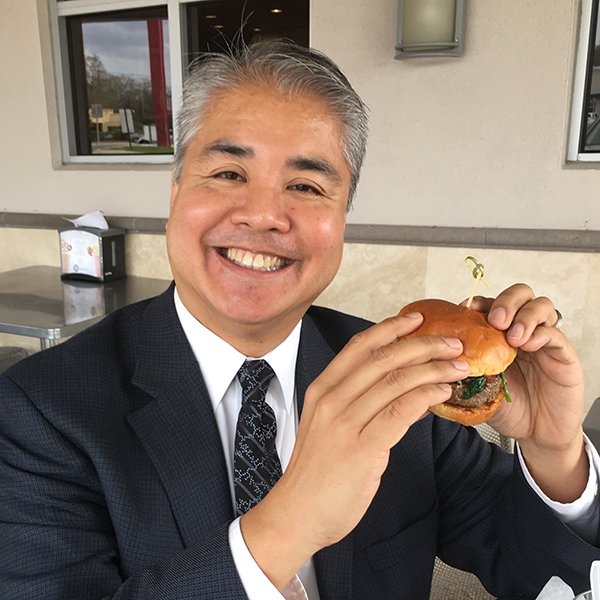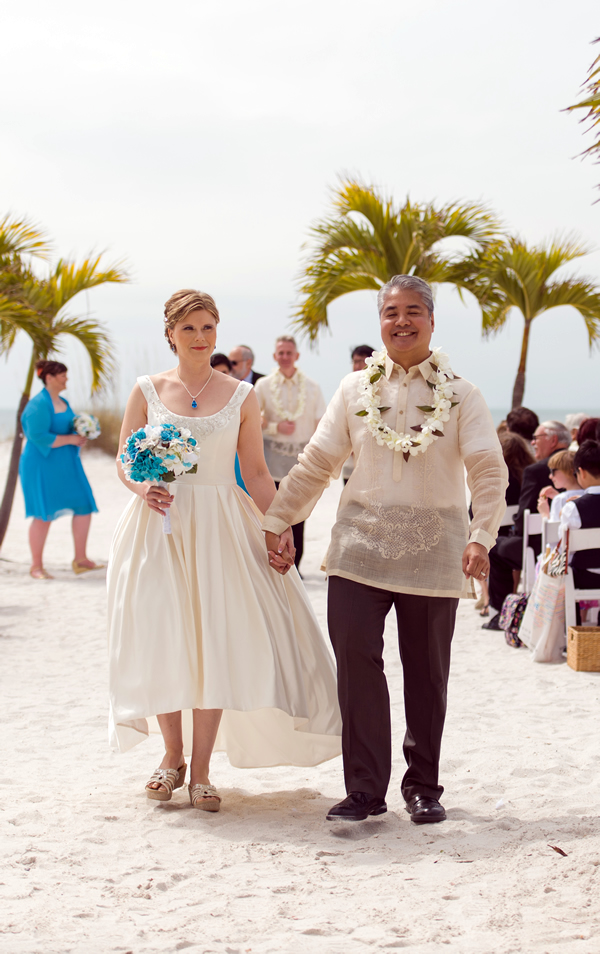Our green card interview


Last Thursday — January 26, 2017 — I acquired permanent resident status in the United States, colloquially known as “getting my green card”. The process took about nine months and a little over US$4,000 in processing and lawyer fees, but it’s done, and from a cursory reading of recent news headlines and from what I heard at the U.S. Citizenship and Immigration Services offices, not a moment too soon.
In case you’ve forgotten or don’t know me that well, there’s a reason why I moved from Toronto to Tampa…


…and she’s why I started the green card process last April.
With the help of our lawyer, Gerry Seipp, we started the process with me filling out an I-485 form (Application to Register Permanent Residence or Adjust Status) and Anitra filling out an I-130 (the interestingly named “Petition for Alien Relative” document). Using a lawyer wasn’t strictly necessary, but I found that it was well worth the $2,500 to have some professional assistance in navigating through the myriad forms, byzantine processes, and potential pitfalls.
Nine months of paperwork, payments, processes (including a medical exam), and a lot of waiting in between culminated in last Thursday’s appointment at the Tampa U.S. Citizenship and Immigration Services office. The appointment is an in-person interview, and its purpose is to confirm that ours was a genuine marriage and not just one of convenience for the purpose of securing a green card.
Gerry told us that in some of these sessions, they separate the spouses and interview them separately, asking questions intended to reveal whether or not they are truly a couple. “Don’t worry about that part,” our lawyer said, “you’re a real couple, and it’ll be just like being on that old game show, The Newlywed Game.”
The problem with that reassurance is that when I think of The Newlywed Game, I always think of the infamous moment on the show, often referred to (somewhat incorrectly) as the “That would be the butt, Bob” moment:
Great, I thought. Now that’s all I’ll be able to think of during the interview.
I was planning on wearing a blazer, dress shirt, and dress pants, but asked if I should wear a tie. Since this is Florida, and since not all of Gerry’s clients are professionals, he told us that he’s seen people show up for the interview in shorts and flip-flops.
“You know what?” I said. “I’m going to wear a tie.”
Our appointment at the Tampa U.S. Citizenship and Immigration Services office was scheduled for 12:15 p.m.. We met up with Gerry a half hour prior in order to have some time to talk and go through the airport-style security line, complete with metal detector and baggage x-ray machine.
This was not my first visit to Citizenship and Immigration Services; I’d been there a couple of times before for other parts of the green card application process. Maybe it was our impending interview, but the mood there was noticeably different this time (and keep in mind that this was the day before what’s now known as the Muslim Ban). There was a general level of anxiety in the waiting applicants’ faces that I didn’t see during my previous visits. It probably didn’t help that the TV screens in the waiting room were tuned to various news stations, all of whom were showing the then-breaking story that Mexico’s President Nieto had canceled his meeting with President Trump over his official announcement that the U.S. would build a border wall that Mexico would pay for.
The local immigration lawyers seem to know each other. While we waited for our interview, a number of other lawyers came up to Gerry to say hi. He introduced us to all of them, and we had some brief — and very interesting — conversations with them:
- One lawyer whose clients had just completed the interview said that the questioning had become more extensive. “My couple got nearly a hundred questions,” he said.
- The next lawyer shared his observation that the interviewers were becoming increasingly hard on less articulate candidates. “That shouldn’t be a problem for me,” I said, to which he replied “Radio voice. That’ll help.”
- Another lawyer, who was waiting with his clients for their interview, said “Things are different with you-know-who in charge,” saying “you-know-who” using the same tone of voice that Harry Potter characters use to say “Voldemort”.
- The most interesting comment came from a lawyer who remarked “If your last name begins with ‘Al’ and ends with ‘i’, let’s just say that you’re not gonna have a good time in that room.”
Our turn came, and interviewer was a friendly guy with an easygoing demeanor. In another life, he could’ve easily been in sales or marketing. After the usual introductions and handshakes, he walked us to his office, where Anitra and I took seats in front of his desk, and Gerry took a seat behind us. The seating arrangement wasn’t all that different from the one pictured above.
After a brief swearing-in where we affirmed that everything we would say in the interview was the truth, it began. First came a review of the forms we’d filled out months ago to ensure that all the information they contained was accurate. Then came our turn to provide supporting documentation:
The guidance on how much supporting documentation to bring to a green card interview is pretty vague — the general rule seems to be “more is better”. I tried to strike a balance between having enough material to prove beyond a shadow of a doubt that our relationship was genuine and not spending an inordinate amount of time and printer ink on preparing it. In the end, I believe I printed out about 60 pages’ worth of material, including:
- Proof that Anitra and I were both professionals with good prospects and jobs that paid well,
- statements that showed that we had joint bank accounts, insurance policies, and other jointly-owned assets,
- photos, photos, photos: from our wedding, as well as from life before and after we got married, including our trips to places both near (Disney World, Charleston, Savannah, Bahamas, Toronto, Montreal, Quebec City, Grand Canyon, Las Vegas, San Francisco, and most recently, New York) and (Manila and London, both of which we visited in 2016), and
- flight itineraries showing that we saw each other monthly before I moved to Tampa in March 2014.
We also provided a sealed envelope containing the results of a medical exam performed specifically for my green card application. The exam took place in August, and a couple of weeks later, I was given in the results in a brown envelope marked “USCIS only — DO NOT OPEN”. Our interviewer opened it, saw that I’d been given a clean bill of health, and then noticed that whoever filled out the paperwork within forgot to specify the clinic where I’d been examined.
“The doctor signed it, which is the important part,” the interviewer said, “but I need to enter a name for the clinic into the system.”
“Mind if I check my phone?” I asked, and a moment later, I had the name and address of the clinic.
We must’ve presented well, because the interview wrapped up shortly after that. Aside from being asked if we lived in the same house and if I’ve ever been convicted of a crime or been denied entry into the United States, I don’t recall being asked any of the questions typically asked in a green card interview. We spent most of the interview reviewing the contents of the folders that I brought.
A half-hour after the interview began, it concluded with our interviewer saying “Congratulations. You are now a legal permanent resident of the United States.” He said I should expect the actual green card in the mail in a couple of weeks.
Since my status was gained through marriage and since Anitra and I have been married less than two years, my permanent residence status is conditional and temporary. Two years from now, we’ll have to file an I-751 (Petition to Remove Conditions on Residence) form to seal the deal.
In case you were wondering how I’ve been working in the U.S. since 2014 without a green card: From March 2014 until last summer, I’ve been here under TN-1 (NAFTA Professional) status, and in the process for applying for a green card, acquired I-512 “Advance Parole”.
Recent Posts
A reminder for April Fools’ Day
Have a good April Fools’ Day tomorrow, but be mindful about your pranking.
How NOT to sell a computer
As I’ve written before, I sometimes browse Facebook Marketplace for nothing more than pure entertainment,…
Happy 10th anniversary, Anitra!
Ten years ago today, this happened: And since that day, it’s been an adventure. Thank…
Last Sunday’s accordion gig in Bonita Springs
It’s been over a year since I’ve played with Tom Hood’s band, the Tropical Sons.…
My plans for Burns Night 2025
Here’s the main course for dinner tonight... ...and that’s because it’s January 25th today, making…

View Comments
Congrats Joey!
Congratulations Joey! And thanks for sharing your story. I think far too many Americans have no concept of how difficult our government makes the process.
Way to go man!!!! Couldn't have happened to a nicer guy.
Only $4,000 huh. That sounds like a bargain. I hope that you find the price you paid to be worth the effort. I wish you good luck.
It keeps me and the Missus together, so yeah, it’s worth it.
Great. When did you file for the green card process? I filled in November and still waiting for the interview to be scheduled...
Also, did you send the medical exam prior to submitting the process, or you kept it with you the whole time? My attorney said it had to be sent to the USCIS, which they did internally. I don't have a copy of my medical file.
From the first phone call to an immigration lawyer to the interview, it was 9 months.